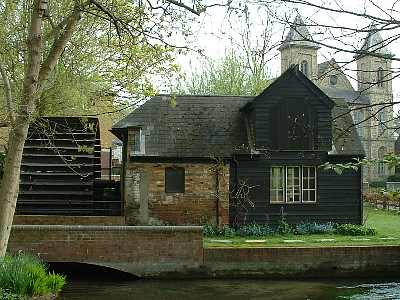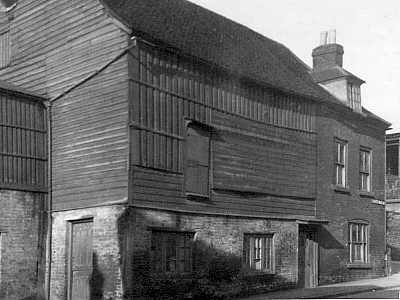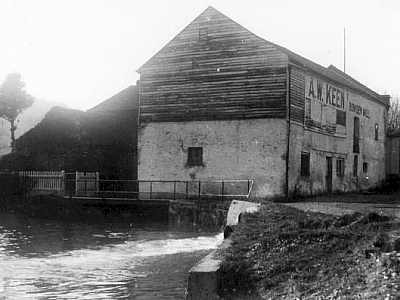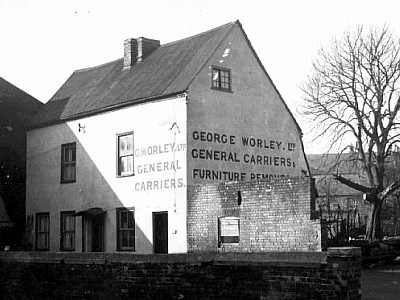
High Wycombe Water Mills in the Domesday Book
High Wycombe, Buckinghamshire. Local History
The Wye Mills
In the Domesday Book (1086) there are 20 mills mentioned on
the River Wye:-
3 in West Wycombe valued at 20 shillings.
6 in High Wycombe valued at 75 shillings.
3 in Lude = Loudwater valued at 14 shillings.
8 in Wooburn valued at 104 shillings.

Pann Mill 2003.
In 1815, there were 34 mills between West Wycombe and Bourne End. Most of them were originally corn mills but many became fulling mills in the Middle Ages and most of these changed to paper mills in the 18th century.
The first edition Ordnance Survey map of 1874 shows the following 16 mills between
West Wycombe and Loudwater:-
A saw mill in West Wycombe Park
A corn mill in Gillotts Lane
An unlabelled building at Lower Mill End (Fryer's Mill)
Lord's Mill in Oakridge Road
Ash Mill (corn) in Westbourne Street
(Temple Mill not shown as in a fully built-up area)
Bridge Mill (corn) in St. Mary's Street
Pann Mill (corn) in Easton Street
Rye Mill (paper) in London Road
Bassetsbury Mill at the Manor
Marsh Green Mill (corn) on a backwater from the Dyke
Bowden Mill (corn) opposite Hatters Lane
Marsh Mill (paper) opposite Cock Lane
Beech Mill (paper) on a backwater in Back Lane
An unnamed paper mill in London Road,
0.25 miles N.E. of Loudwater (King's Mill)
Loudwater Mill (paper) near the junction of the Bourne End Road
Also Overshot Mill(paper & corn), Snakeley Mill(paper) and
Hedge Mill(paper), downstream from Loudwater Mill
Earlier maps show the following :-
1596 Hovenden map :- Ash Mill
1774 "65 miles around London" (Andrews & Drury)
West of Wycombe :- Francis, Frier's Ball's, Lane's
East of Wycombe :- New and Hedge
1796 West :- Francis, Frier's, Ball's, Lane's.
Nothing shown to East.
1832 Only shows Rye Mill as such, and Marsh Green and Bowdens
as localities.
Dealing with those Mills west of the Town centre, the approximate distances, in miles, from the Guildhall are:-
Ash: 0.39 miles, Lord's: 0.73, Frier's: 1.13, Gillott's: 1.40
1774 map Lane's: 0.43 miles, Ball's: 0.71, Frier's: 1.15, Frances: 1.35
1796 map Lane's: 0.42 miles, Ball's: 0.73, Frier's: 1.04, Frances: 1.18

Fryers Mill. (Bucks CC Collection)
The distances on the 18th. century maps are only very approximate.
The 1796 map shows a building some 250 yards west of Ball's Mill and
this is probably Froghall Farm.
Lane's Mill is Ash Mill. It was Ash Mill in 1596.
Ball's Mill is Lord's Mill.
A document of about 1230 (Chichester Chapter Archives) refers to the pasture
of Acruge (Oakridge) between St. Giles Hospital (near Desborough Rd. School)
and the mill of the Lord Bishop of Winchester. As West Wycombe belonged to
Winchester, and as Lord's Mill in Oakridge Rd. was in West Wycombe Parish,
the mill is probably named after the Lord Bishop of Winchester.
Frier's Mill is the same on all maps.
Gillott's Mill was formerly known as Frances Mill.
The saw mill in West Wycombe Park shown on the 1874 O.S. map, and on more recent maps as Saw Mill House, was probably an 18th or 19th century building.
East of the town centre the mills have the same names on all the maps, except New Mill on the 1774 map. This is probably the same as the anonymous Paper Mill near Loudwater on the 1874 O.S. map, although its precise position in 1774 is not clear. This was called King's Mill in the 18th or 19th century, named after the owner Mr.King.

Ash Mill 1939. (Bucks CC Collection)
The Domesday Mills
To identify the Domesday Mills, it is safe to assume that the 3 West Wycombe mills are Gillott's, Frier's and Lord's.At Loudwater a mill called "New" in 1774 would hardly be 700 years old (it was probably built in the early 18th century),so the 3 mills in Lude would be Loudwater, Hedge and one other. The identification of Lude as Loudwater is confirmed by a reference in L.J.Ashford's book stating that in about 1235 "Thomas de la Lude was given permission to build a new fulling mill at Loudwater."
This leaves 10 mills in High Wycombe :- Ash, Temple, Bridge, Pann, Rye, Bassetsbury, and 4 in the Marsh: Marsh Green,Bowden, Marsh and Beech, and the earliest known dates of these must be determined.
There are several mills mentioned in a document at the County Records Office in Aylesbury which is a transcript made in about 1730 of certain items in the Court Rolls of Temple Manor, mainly concerning properties in Totteridge and the Marsh.
Earliest dates are :-
Ash Mill 1586, Bowdens Mill 1727, Pann Mill 1495, Temple (St. John's) Mill 1607.References to other mills are :-
1542 : Geo. Landsdale hath levyed a new mill to the annoyance of Kings Mill.
1506 : Watercourse at the Marsh near Gowes Mill obstructed.
1626 : Edward Sherwood has built at the fulling mill called Gosham's Mill.
( Gowes & Gosham's have not been identified )

Bowden Mill 1930's. (Bucks CC Collection)
Which of these 10 mills are the 6 referred to in Domesday?
Marsh Green and Beech Mill are on a backwater of the Wye and are unlikely to be ancient. They are believed to have been built in 1759 and 1739.
The 1542 reference above reports a new mill constructed to the annoyance of King's Mill. The new mill was obviously upstream of King's Mill, but which was King's Mill ? It was certainly not New Mill,called King's Mill in the 18th or 19th century. Between 1326 and 1483 Bassetsbury Manor belonged to the Crown, so the King's Mill was probably Bassetsbury Mill. In that case the new mill would be Rye Mill, some 350 yards upstream.
The other mill very close to others is Bowden's Mill, between Bassetsbury and Marsh Mill, and this could be the other post-Domesday mill on the main river. J. Rattue states that "As the 13th century wore on, these (the Domesday Mills) were joined by Rye and Bowden's Mills."
This leaves 6 mills which are probably those referred to in Domesday :-
ASH, TEMPLE, BRIDGE, PANN, BASSETSBURY, and MARSH MILLS.

Temple Mill 1939. (Bucks CC Collection)
Very little remains of these mills except for Bassetsbury Mill which is well preserved and Pann Mill which has recently been partially reconstructed after demolition by the Council in 1971. Buildings remain at West Wycombe, Marsh Green, Marsh Mill, Beech and Snakeley Mills. The mill wheel exists at Lords, the mill leat at Bridge and the mill race at Rye Mill.
Related pages:
Strata Dusteburg
Old roads through High Wycombe.
All Soul's College properties in Wycombe:
Ash and Temple Mills.
Sept. 2003
K.A.Goodearl
Chorleywood
U.K.
K.A.Goodearl
Chorleywood
U.K.